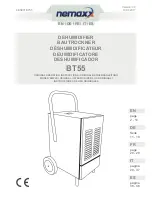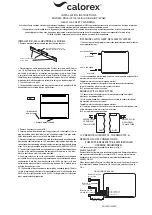
SRC Service Manual
Revision 02
Aug 2007
Air Inlet Pressure Correction Factor (C)
Ambient temperature (
o
F) 50 80 100 125 150 170 190 200
Correction Factor “C”
0.76
0.93
1 1.03 1.11 1.14 1.16 1.17
13.2 An
Example
To determine the maximum air flow capacity of a given dryer at any set of given conditions, apply the
correction factors given above, using the following equation:
Rated Inlet Air Flow x A x B x C
Where:
•
A = the correction factor for the maximum ambient temperature,
•
B = the correction factor for the maximum inlet air temperature, and
•
C: the correction factor for the minimum inlet air pressure.
This will give the maximum amount of flow the dryer can handle at those conditions. You can then
compate that to the actual air flow to determine if the dryer is undersized for the application.
Example: A customer complains that every day around noon, his SRC-400 shows an “Hd” (High
Dewpoint) alarm. You ask him to confirm the actual operating conditions when the alarm occurs,, and
after consulting with his plant manager, he tells you the following:
Air Flow (cfm) =
300 cfm
Ambient Temperature (
o
F) =
100
o
F
Inlet Air Temperature (
o
F) =
120
o
F
Inlet Air Pressure (psig) =
125 psig
Using the above correction factor tables you quickly find the three Correction Factors are:
A = 1.08, B = 0.80, C = 1.03
Using your calculator, and knowing that an SRC-400 is rated for 400 cfm at standard conditions, you
plug these values into the formula and find out that the maximum capacity of the SRC-400 at those
conditions is:
400 cfm x 1 x 0.63 x 1.03 = 260 cfm
So, the customer is putting more air flow through this dryer than it is designed to handle. This is what
is causing the High Dew point alarm.
You can tell him that he needs to call his local Sullair distributor and order an SRC-500, which would
adequately handle his 300 cfm at these warm conditions (since 500 cfm x 1 x 0.63 x 1.03 = 324 cfm).
Page 56 of 56

































